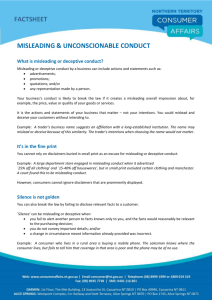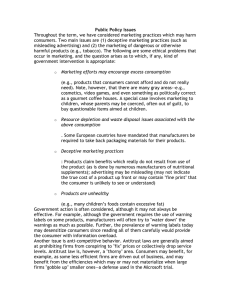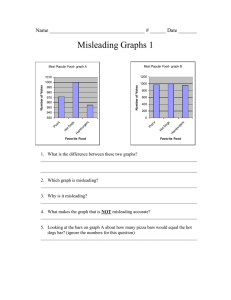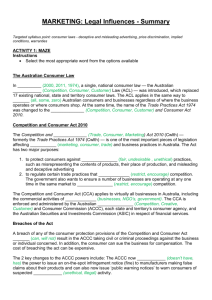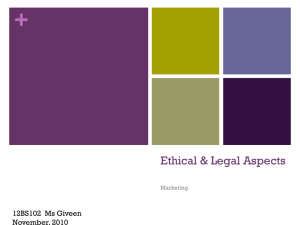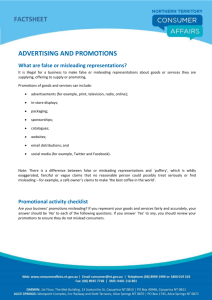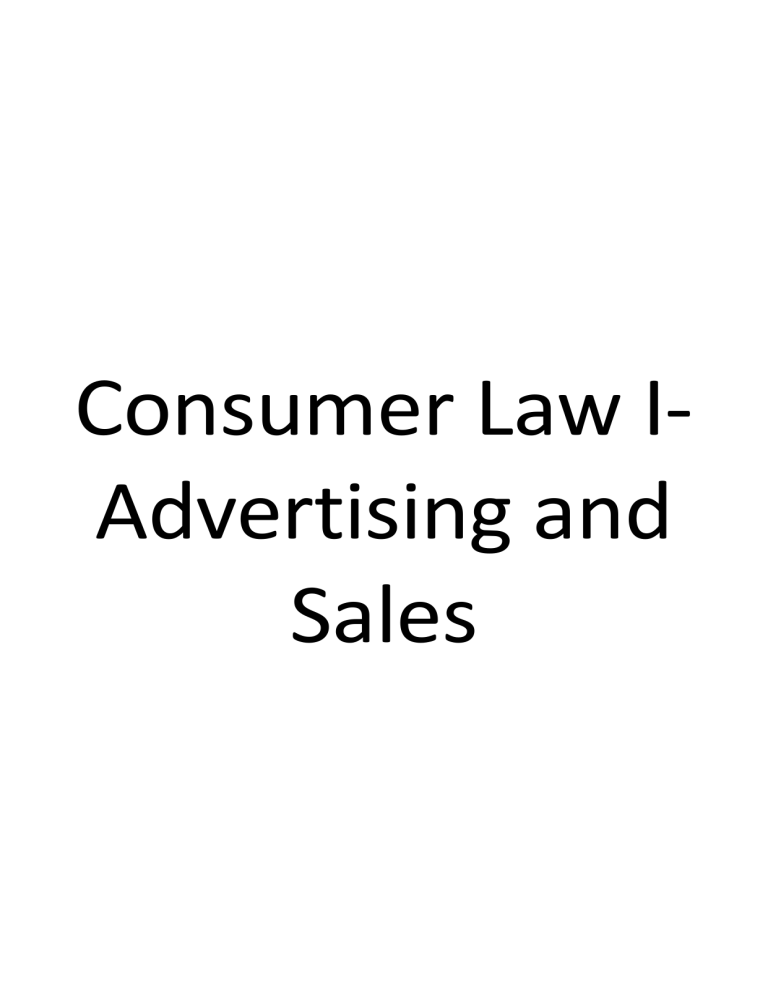
Consumer Law IAdvertising and Sales Use the below template for answering misleading or deceptive conduct / false or misleading representations There two elements in common for s18 and s29: (important IN-CHRONOLOGICAL order) (same thing) 1. Person- identify parties involved. 1-2 sentence. 2. In trade or commerce- are parties conduct involved in trade or commerce. 1 sentence. (exchange of money) For s18 (Deceptive or Misleading Conduct) 3. Conduct- two sentence. ‘the type of conduct here is advertising’. See notes 4. Whether the conduct is misleading or deceptive or likely to mislead or deceive- 3 steps a. Identify the target audience. b. The message this advertisement conveys to that particular audience. (before start c add magic sentence) c. Whether this leads those consumers into error. Magic Sentence (can copy- guaranteed 1-2 Marks)- ‘it does not matter whether or not the defendant intended to convey the misleading message to its audience of consumers- intention to mislead or decive is not required for s 18. It also doesn’t matter whether or not anyone has actually been misled or deceived by the conduct.’ For s29 (False or Misleading representations) need identify at least one of the subsections. Copy the blow sentence. Magic Sentence: Next we should consider s29 of the ACL. To establish false misrepresentation, other than the element elements of ‘person’ and ‘in commerce’, we also need to identify the type of contravention that each representation falls into (see notes). So just go through conduct and whether the conduct is mislead or deceptive or likely to mislead (follow the above template). - For example: False testimonials found in the scenario given i.e. ‘90% of customers have lost 10 kgs in the first month!’ Then the fines for breach s29 of ACL. - Magic Sentence: ‘A finding that s 29 applies brings us to the point that s 29 is a criminal offence provision carrying significant amount of fines. SIDE NOTE: the Legal Authority are the s18 and s29. For s18 and s29: make sure you talk about person and trade or commerce first before everything. Person: whether the defendant is a person? Natural or company? Focusing on the following topics: - Misleading or deceptive conduct: this has particular significance for advertising but also applies more broadly to other types of conduct S18 of ACL False or misleading representations: more specific categories of representation that are prohibited if they are false or misleading to consumers S29 of ACL Unfair contracts or terms: situations in which sales contracts, or terms of sales contracts, may turn out to be unenforceable because they were inherently unfair S20-28 of ACL Prohibited sales methods: sales practices that are prohibited by law S29 of ACL Overview of Misleading or Deceptive Conduct s18 Misleading or deceptive conduct is business activity that misleads or deceives consumers (or has the tendency to mislead or deceive consumers) about some matter relating to a good or service provided by the business. A common example of misleading or deceptive conduct is false advertising: promotion of a product or service in a way that misrepresents the suitability or other characteristics of the good or service. Other conducts are: - providing professional advice managing bank accounts and financial services labelling food and drink products franchising selling real estate marketing and conducting sports events. Section 18: 1) A person must not, in trade or commerce, engage in conduct that is misleading or deceptive or is likely to mislead or deceive. ‘Persons’: not only applies to individuals or sole traders but to possible business structures (partnership, companies and trusts). In effect, it applies to all business. ‘Conduct’: i.e. advertising even commissioning for false advertisement. Other behaviours that are held account include: - - Making-precontractual Statements: a MOD statement made to induce another party to enter a contract (see contract law notes). Expressing opinions or representation about the future: Where a businessperson makes a representation about some future state or condition knowing that statement to be false or having no reasonable basis for making the statement. Staying silent or doing nothing: Silence (or the holding back of relevant information) will constitute misleading or deceptive conduct if an ordinary person would reasonably expect to be told that information due to its relevance or importance to the transaction being considered. ‘In trade or Commerce’: conduct be commercial in character. ‘Trade’ selling goods or services. Important to note that conduct must occur ‘in’ trade and commerce rather than merely being related to it. Consequently, courts have ruled that activities such as education, political campaigns, and actions within the workplace are not subject to s 18. ‘When is conduct misleading or deceptive’? conduct which affects customers will be considered MOD if it leads consumer into error or cause consumers to believe something about a good or service that is inaccurate or false. Confusion but not error- not considered MOD. - - What is the relevant class of consumers? Group of people that is likely to be exposed to the conduct in question. To whom is the conduct directed: specific individuals, target audience or the public at large? What meaning would the conduct convey to that class of consumers? Consider the conduct from POV of the relevant class: what would an average member of that class understand the conduct to mean? May be necessary for the court to identify a hypothetical ‘representative member’ of the class and to determine the meaning of the conduct through eyes of this person i.e. Weight loss advertisement- directed toward individuals who wish to lose weight. Would the conveyed meaning MOD the relevant class of consumers? An objective, rather than subjective test: would an average member of the class be led into error about the product? Yes, then conduct is MOD. Disclaimers and Exclusion Clauses and Labelling: A disclaimer is a statement that seeks to exclude the maker of the statement from legal liability. Disclaimers in the form of exclusion clauses in contracts, which seek to excuse the business from liability under the ACL. disclaimer may be effective if its effect is to avoid any suggestion of misleading or deceptive conduct from arising in the first place. Even if a product has a close resemblance to the product of another manufacturer to the point where a consumer would be likely to be misled, if the product is properly labelled with the name of its own manufacturer, will not breach s18. See below. Comparative Advertising: Special care must be taken by the advertiser to ensure the accuracy of its advertising. The problem for the advertiser is that the potential to mislead is far greater when using comparative advertising, as Re Hoover (Australia) Pty Ltd v Email Ltd illustrates. Means that: - - Comparisons must be accurate, and like must be compared with like. All relevant information must be disclosed so that comparisons do not create a false impression. Tests that show up differences between products and suggest that one may be inferior to the other must be conducted by qualified independent researchers. For example, in Colgate-Palmolive Pty Ltd v Rexona. Rexona had to be able to support its claim that its new toothpaste was 50– 90% more effective at fighting plaque; however, its claims were largely unpublished and had not been independently assessed by the dental profession, thus breaching s 18, and the company was ordered to withdraw its advertisements. Claims that lack truth or substance should be avoided. Overview of False or Misleading Representation s29 For ‘person’ and ‘in trade or commerce’ refer to s18 above. S 18 v s 29: s29 applies to false representations rather than conduct - - Both have civil consequences s 29 carries criminal consequences of fines (more serious-law see false representation more seriously). If a company breaches s29 then the fine is not to be more than the greater of the following: A) $10 million; B) if the court can determine the value of the benefit that the company has obtained directly or indirectly attributable to the commission of the offence then 3 times the value of the benefit; C) if the court cannot determine the value of that benefit, then 10% of the annual turnover of the company during the 12 month period ending at the end of the month in which the company committed, or began committing, the offence. For a breach by a human then fine shall not exceed $500,000. The Types of Contravention of s29: Category of false or misleading representation Examples: Standard, quality, value, or grade of goods or services s 29(1)(a), (b) Standard: compliance with ‘official’ types of standards, such as Consumer Safety Standards for flammability of children’s nightclothes or Standards Association of Australia Standards Quality: claiming a toothpaste inhibits plaque formation when this is not proven; inaccurate ‘green’ or ‘organic’ statements Value: ‘unlimited’ download times; ‘per minute’ charges for overseas calls Grade: ‘restaurant grade’ meat That a particular person has agreed to acquire goods or services s 29(1)(d) Representations that appear to be testimonials s 29(1)(f) prohibits false representations that goods or services have been ordered by a particular person when they have not. Sponsorship, approval, performance characteristics, accessories, uses or benefits of goods or services s 29(1)(g) ‘Testimonials’ are endorsements or recommendations of a business or product by previous purchasers or other third parties (sometimes celebrities). They create the impression that other people are happy with the product or service, which encourages new customers to buy it. Fictitious testimonials (i.e. where the business has made the ‘testimonials’ up itself) or false or misquoted testimonials (where the person’s comments have been changed) are prohibited. Sponsorship or approval: if good are sponsored (must be true) and approved by independent ORG (must be true). Performance characteristics: effectiveness of an air freshener or a weight loss program; scientific or medical results and (possibly) also the safety of products Uses: either fits for its use or not Benefits: inaccurate claims about benefits the product or service has, e.g., healing qualities of ion mats Sponsorship, approval or affiliation of persons making the relevant representations s 29(1)(h) Price s 29(1)(i) Need for goods or services s 29(1)(l) Composition, style, model, history or previous use of goods s 29(1)(a) Goods are new s 29(1)(c) Availability of repairs and spare parts s 29(1)(j) Origin of goods s 29(1)(k) Existence, exclusion or effect of any condition, warranty, guarantee, right or remedy s 29(1)(m) Requirement to pay for existing rights s 29(1)(n) Sponsorship or approval: see above Affiliation: describing oneself as a CPA (‘Certified Practising Accountant’) when not a member of that representative body Advertising the wrong price for goods or services Inflating the price before reducing it so the ‘saving’ looks bigger Offering goods as ‘marked down’ although they have never been offered at the higher price Not including on-road costs in the ‘full’ price of a car Advertisements inaccurately suggesting particular medical conditions are serious and require treatment. Misrepresenting the need to be included in a directory claimed to be affiliated with the government Composition: type and amount of fruit in fruit juices and cordials; the components of fabrics (e.g. 50% wool) Style / Model: depicting a 2009 model and stating its 2019 History or previous use: ex-rental cars sold as exexecutive cars (i.e. used by executives of the manufacturer); mileage of cars. New, as opposed to used or second-hand. A ‘new’ car may have much older compliance plates (up to 20 months in one case) but still be considered ‘new’, as opposed to second-hand. However, in some circles new may mean ‘recently made’. The particular audience should be kept in mind when making such claims Promoting the availability of facilities for repair and / or of spare parts for goods when none are available. Manufacturers are also required to provide spare parts and repair facilities for reasonable periods after purchase of goods. Making a false or misleading representation about the origin of any goods is a breach of this section. The issue has particular relevance to foods. ‘No refunds’ signs (consumers have a right to a refund under the ACL if goods are faulty or services are deficient — a sign stating the opposite is therefore false). Telling a customer that they must pay for the right to a refund if a good is faulty or a service is deficient (this right already exists under the ACL and consequently, the statement is false).
